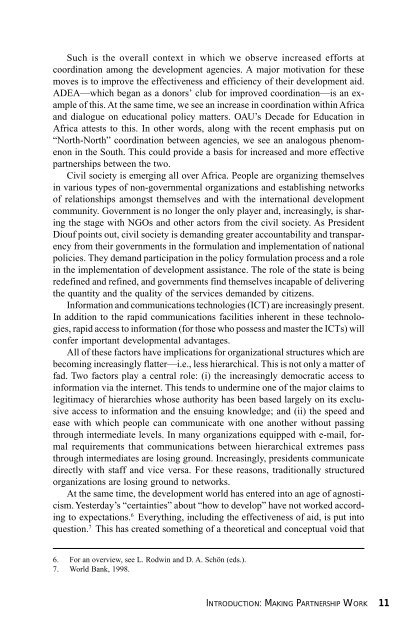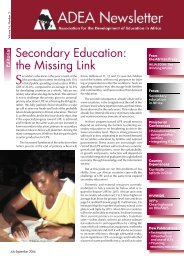Partnerships for Capacity Building and Quality ... - ADEA
Partnerships for Capacity Building and Quality ... - ADEA
Partnerships for Capacity Building and Quality ... - ADEA
Create successful ePaper yourself
Turn your PDF publications into a flip-book with our unique Google optimized e-Paper software.
Such is the overall context in which we observe increased ef<strong>for</strong>ts atcoordination among the development agencies. A major motivation <strong>for</strong> thesemoves is to improve the effectiveness <strong>and</strong> efficiency of their development aid.<strong>ADEA</strong>—which began as a donors’ club <strong>for</strong> improved coordination—is an exampleof this. At the same time, we see an increase in coordination within Africa<strong>and</strong> dialogue on educational policy matters. OAU’s Decade <strong>for</strong> Education inAfrica attests to this. In other words, along with the recent emphasis put on“North-North” coordination between agencies, we see an analogous phenomenonin the South. This could provide a basis <strong>for</strong> increased <strong>and</strong> more effectivepartnerships between the two.Civil society is emerging all over Africa. People are organizing themselvesin various types of non-governmental organizations <strong>and</strong> establishing networksof relationships amongst themselves <strong>and</strong> with the international developmentcommunity. Government is no longer the only player <strong>and</strong>, increasingly, is sharingthe stage with NGOs <strong>and</strong> other actors from the civil society. As PresidentDiouf points out, civil society is dem<strong>and</strong>ing greater accountability <strong>and</strong> transparencyfrom their governments in the <strong>for</strong>mulation <strong>and</strong> implementation of nationalpolicies. They dem<strong>and</strong> participation in the policy <strong>for</strong>mulation process <strong>and</strong> a rolein the implementation of development assistance. The role of the state is beingredefined <strong>and</strong> refined, <strong>and</strong> governments find themselves incapable of deliveringthe quantity <strong>and</strong> the quality of the services dem<strong>and</strong>ed by citizens.In<strong>for</strong>mation <strong>and</strong> communications technologies (ICT) are increasingly present.In addition to the rapid communications facilities inherent in these technologies,rapid access to in<strong>for</strong>mation (<strong>for</strong> those who possess <strong>and</strong> master the ICTs) willconfer important developmental advantages.All of these factors have implications <strong>for</strong> organizational structures which arebecoming increasingly flatter—i.e., less hierarchical. This is not only a matter offad. Two factors play a central role: (i) the increasingly democratic access toin<strong>for</strong>mation via the internet. This tends to undermine one of the major claims tolegitimacy of hierarchies whose authority has been based largely on its exclusiveaccess to in<strong>for</strong>mation <strong>and</strong> the ensuing knowledge; <strong>and</strong> (ii) the speed <strong>and</strong>ease with which people can communicate with one another without passingthrough intermediate levels. In many organizations equipped with e-mail, <strong>for</strong>malrequirements that communications between hierarchical extremes passthrough intermediates are losing ground. Increasingly, presidents communicatedirectly with staff <strong>and</strong> vice versa. For these reasons, traditionally structuredorganizations are losing ground to networks.At the same time, the development world has entered into an age of agnosticism.Yesterday’s “certainties” about “how to develop” have not worked accordingto expectations. 6 Everything, including the effectiveness of aid, is put intoquestion. 7 This has created something of a theoretical <strong>and</strong> conceptual void that6. For an overview, see L. Rodwin <strong>and</strong> D. A. Schön (eds.).7. World Bank, 1998.INTRODUCTION: MAKING PARTNERSHIP WORK 11

















